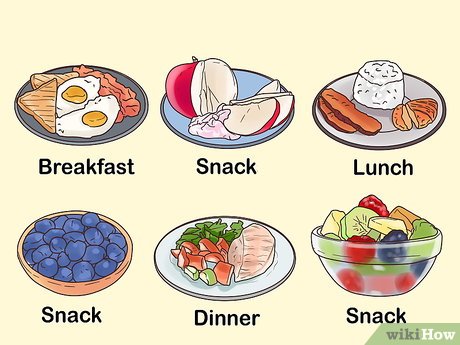
It is essential that children are exposed to as many food options as possible in order to encourage healthy eating habits. The more variety a child has, the more they will like it. Children may feel as though they aren't getting enough of whole foods. A healthy diet is a good way to ensure that your children grow up to be healthy adults.
Teaching children how to enjoy food is one of the best ways to instill healthy eating habits. The first step to creating healthy eating habits is to have a positive relationship. Children are more likely than their parents to have a healthy relationship with food. Bad eating habits can include eating too many foods high in sugar, salt and added fat. This will lead to a reduction in fruit and vegetable consumption, increased screen time, and increased physical activity.

Limit snacking to an hour before dinner. Snacks can also be avoided, as a daily snack isn't necessary for most children. A family should eat one meal per day. Make this the family dinner. Turn off your television and other electronic devices before you start the meal. Sit down with your child and encourage him or her to try a variety of foods. Don't worry about a mess, but discourage throwing food when you're eating together.
While it's vital to ensure that your child has a diverse diet, it's also important to encourage healthy eating habits in your own household. Start by avoiding unhealthy foods in your own household. Your child will soon begin to steal unhealthy foods from you. If you aren't careful, your child will soon be begging for unhealthy food. Teaching your child about food is a responsibility of every parent. They should be able to tell you about the source of each food, the growth of animals and the amount of calories in a particular item.
The best way to establish healthy eating habits for kids is to set the standards early. They will be more likely to follow these rules as they grow up. Parents should also avoid giving their children food that they don't need. For example, a cookie could be the only snack your child needs, but not an apple and a banana. Instead, offer them apples and hummus. Eating unhealthy snacks is not a good way to start a healthy eating routine.

Your toddler is notoriously fussy eaters. While it's important to limit portions to avoid the feeling of hunger, it's equally important to let your child choose how much they eat. This way, they'll be more likely to eat the food that they're hungry for and not overeat. They will be more likely to choose the food they find most appealing.
FAQ
What is the healthiest lifestyle to life?
Living a healthy lifestyle is one that encourages you to eat well, exercise regularly, get enough sleep, and avoids stress. These guidelines will help you live a long, healthy life.
Start small by changing your diet and exercising routine. To lose weight, you can start walking for 30 mins each day. For more activity, you can try swimming or dancing. An online fitness program such as Strava or Fitbit that tracks your activity could be a good option.
How can I live my best life everyday?
The first step towards living your best life everyday is to find out what makes you happy. You can then work backwards once you know what makes YOU happy. You can also ask other people what they do to live the best lives possible every day.
You can also find books such as "How to Live Your Best Life" written by Dr. Wayne Dyer. He talks about how to find happiness and fulfillment at all stages of our lives.
What are the 7 tips to have a healthy life?
-
Take care of your health
-
Exercise regularly
-
Rest well
-
Get plenty of water.
-
Get enough rest
-
Be happy
-
Smile often.
What's the problem with BMI?
BMI stands for Body Mass Index. This is a measure of body fat that is calculated based on height or weight. This formula calculates BMI.
Weight in kilograms divided by height in meters squared.
The result can be expressed as a number between zero and 25. Scores between 0 and 25 indicate obesity. A score of 18.5 indicates overweight. A score of 23 indicates obesity.
A person who weighs 100 kg and has a height of 1.75 m will have a BMI of 22.
Is cold an indication of a weaker immune system?
According to some, there are two types: people who love winter or those who hate it. But whether you love or hate it, you may find yourself wondering why you feel so lousy when it's cold out.
The reason is simple: Our bodies are made to function well in warm temperatures. Hot climates are where our food sources are most plentiful, and we evolved to thrive there.
Today's environment is vastly different from the one our ancestors experienced. We spend a lot more time indoors, and are often exposed at extreme temperatures (cold and hot), and we eat processed foods over fresh.
Our bodies aren’t accustomed to such extremes. This means that we feel tired, sluggish and even sick when we venture outside.
However, there are some ways to reduce these effects. One way is to make sure that you stay well-hydrated throughout the day. Hydration is key to keeping your body well hydrated, flushing out toxins and keeping your system healthy.
Also, ensure you eat healthy food. The best way to maintain your body's optimal temperature is by eating nutritious food. This is especially helpful for people who spend a lot of time indoors.
It is worth taking a few extra minutes each day to meditate. Meditation can relax your mind and make it easier manage stress and illness.
Statistics
- According to the Physical Activity Guidelines for Americans, we should strive for at least 150 minutes of moderate intensity activity each week (54Trusted Source Smoking, harmful use of drugs, and alcohol abuse can all seriously negatively affect your health. (healthline.com)
- In both adults and children, the intake of free sugars should be reduced to less than 10% of total energy intake. (who.int)
- Extra virgin olive oil may benefit heart health, as people who consume it have a lower risk for dying from heart attacks and strokes according to some evidence (57Trusted Source (healthline.com)
- This article received 11 testimonials and 86% of readers who voted found it helpful, earning it our reader-approved status. (wikihow.com)
External Links
How To
What does the "vitamins” word mean?
Vitamins are organic substances found naturally in food. Vitamins are essential for our bodies to absorb nutrients from the foods we eat. Vitamins cannot come from the body so food must provide them.
There are two types if vitamins: water soluble, and fat soluble. Water-soluble vitamins dissolve in water easily. Examples include vitamin C,B1 (thiamine), B2 (riboflavin), B3 (niacin), B6 (pyridoxine), folic acid, biotin, pantothenic acid, and choline. Fat-soluble vitamins can be stored in the liver or in fatty tissue. These include vitamin D, E and K, as well as beta carotene.
Vitamins can be classified by their biological activity. There are eight major vitamin groups:
-
A - vital for healthy growth.
-
C - important for proper nerve function and energy production.
-
D - necessary for healthy bones and teeth.
-
E is required for good vision and reproduction.
-
K – Required for healthy nerves & muscles.
-
P - vital for building strong bones andteeth.
-
Q - aids digestion and absorption of iron.
-
R - Required for red blood cell production
The recommended daily allowance (RDA), for vitamins, varies depending upon age, gender, or physical condition. The U.S. Food and Drug Administration (FDA) sets the RDA values.
For adults 19 years and over, the RDA of vitamin A is 400mg per day. Pregnant women require 600 micrograms daily to support fetal development. Children ages 1-8 require 900 micrograms per day. Children under 1 year old require 700 micrograms daily, while infants over one year old need 500 micrograms every day. This decreases between 9 and 12 months.
Children aged between 1-18 years require 800 micrograms of sugar per day, while overweight children need 1000 micrograms. Children who are underweight receive 1200 micrograms every day to meet their nutritional requirements.
Children between 4 and 8 years old with anemia will need 2200 micrograms daily of vitamin C.
2000 micrograms daily is required for adults over 50 to maintain their general health. Mothers who are pregnant, nursing, or have a high nutrient need will require 3000 micrograms a day.
Adults over 70 require 1500 micrograms each day, since they lose around 10% of their muscle mass every decade.
Women who have been pregnant or are lactating require more than the RDA. Pregnant and breastfeeding women require 4000 micrograms each day during pregnancy and 2500 Micrograms each day after delivery. Breastfeeding mothers need to consume 5000 micrograms every day when breastmilk has been produced.